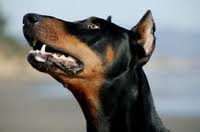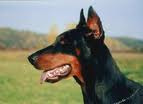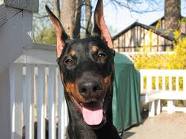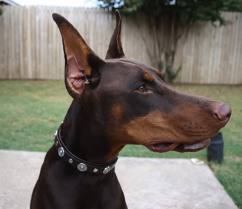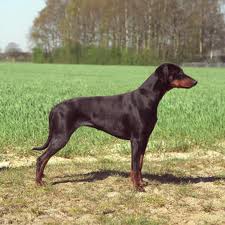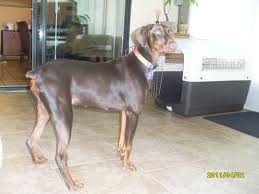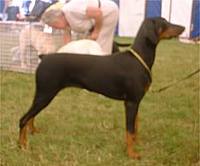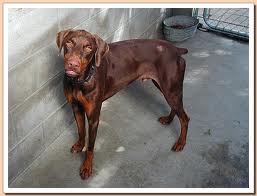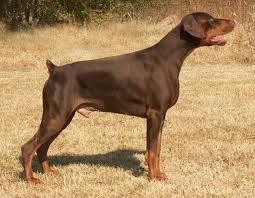Ear Cropping
A little history on Ear cropping...
Ear cropping was typically used for guard dogs to enable better hearing, allow better airflow in the ear to prevent ear infection and make it harder for a attacker to get a hold of. The cropped Doberman is a elegant dog who looks imposing and alert. There is alot of controversy surrounding the procedure. Many think it is a "cosmetic" procedure where many Dobie owners argue that. The procedure is normaly 30min or under and the puppy is sedated during that time so it does not feel pain. I do not believe that ear cropping is any more painful than spaying a dog which is a more in depth procedure. As with any surgery there are risks. The decision to crop a dogs ear should be decided by its owner. Many breeds are only known to look a certain way thus "natural" looking dogs can be mistaken for mixes or other breeds entirely. Cropping and Docking (removing some of the tail) are illegal in foreign countries because of the cosmetic aspects and the pain involved. In all actuality cosmetic surgery was banned because hundreds of years ago they had no way to sedate a dog before removing its ears or tails. Back then it was a very cruel procedure and very painful for the dog. Now with modern technology it can be very quick and just a slight annoyance to a puppy. They get used to it very quickly and many are up and wanting to eat right after surgery.
A doberman pup is born with floppy ears like any other breed. To get the ear to stand the owner takes the puppy to the vet between 7 & 12 weeks to have a portion of its ear removed. This is the "cropping" part of ear cropping. The puppy is placed under sedation for about 30 min. It is a quick procedure. After surgery the ear is sutured along (OR glued) the cut edges and put in a upright brace with the edges exposed to promote healing. After about 10 days the sutures are removed and the ears checked for infection, and cleaned. After the ears have been checked it's time to "post" them. Many different methods exist for posting a pups ears. Some are very fancy, large, complicated and simple. Each has its own advantages but I feel the larger complicated ones tend to be more of a hassle and a bother to the pup. Keep posting times fun and quick.
There are three main types of ear cropping for most breeds including the Doberman. Pet/Military, Medium, and Show crop.
Depending on the crop style and ear leather it may take the ear 1 month to 5 months to stand. The longer the crop, normaly the longer you have to post them. It is not unheard of that ears are still being posted at 1 yr old. Bad crops are normaly very short which is known as the "battle crop" or "pitbull crop" neither are correct for a Doberman.
Click on pictures to enlarge them.
Ear cropping was typically used for guard dogs to enable better hearing, allow better airflow in the ear to prevent ear infection and make it harder for a attacker to get a hold of. The cropped Doberman is a elegant dog who looks imposing and alert. There is alot of controversy surrounding the procedure. Many think it is a "cosmetic" procedure where many Dobie owners argue that. The procedure is normaly 30min or under and the puppy is sedated during that time so it does not feel pain. I do not believe that ear cropping is any more painful than spaying a dog which is a more in depth procedure. As with any surgery there are risks. The decision to crop a dogs ear should be decided by its owner. Many breeds are only known to look a certain way thus "natural" looking dogs can be mistaken for mixes or other breeds entirely. Cropping and Docking (removing some of the tail) are illegal in foreign countries because of the cosmetic aspects and the pain involved. In all actuality cosmetic surgery was banned because hundreds of years ago they had no way to sedate a dog before removing its ears or tails. Back then it was a very cruel procedure and very painful for the dog. Now with modern technology it can be very quick and just a slight annoyance to a puppy. They get used to it very quickly and many are up and wanting to eat right after surgery.
A doberman pup is born with floppy ears like any other breed. To get the ear to stand the owner takes the puppy to the vet between 7 & 12 weeks to have a portion of its ear removed. This is the "cropping" part of ear cropping. The puppy is placed under sedation for about 30 min. It is a quick procedure. After surgery the ear is sutured along (OR glued) the cut edges and put in a upright brace with the edges exposed to promote healing. After about 10 days the sutures are removed and the ears checked for infection, and cleaned. After the ears have been checked it's time to "post" them. Many different methods exist for posting a pups ears. Some are very fancy, large, complicated and simple. Each has its own advantages but I feel the larger complicated ones tend to be more of a hassle and a bother to the pup. Keep posting times fun and quick.
There are three main types of ear cropping for most breeds including the Doberman. Pet/Military, Medium, and Show crop.
Depending on the crop style and ear leather it may take the ear 1 month to 5 months to stand. The longer the crop, normaly the longer you have to post them. It is not unheard of that ears are still being posted at 1 yr old. Bad crops are normaly very short which is known as the "battle crop" or "pitbull crop" neither are correct for a Doberman.
Click on pictures to enlarge them.
Tail Docking
History on Tail Docking...
The Dobermans tail naturally is somewhat long and hound-like. The tail has been Docked for centuries and is as controversal as ear cropping is. Typically a dog's tail is docked because it is a working dog of some sort. Field dogs with flowing hair get mud, and other things in natural tails. It can also collect feces in long haired dogs. Many working dogs such as the Dobie have been docked for other reasons though. A common reason for a docked tail on a dobie is to prevent injury during protection work and to prevent a hand-hold on the dog. Another is to ensure that the tail doesn't get in the way of the dogs work. A very actively working Dobie can have its tail broken since they are not very strong.
Tail docking is a procedure in which the puppies (normaly done less than 5 days old) tail is removed. Depending on breed some docked tails are longer or shorter. The Doberman's tail is docked typically at the second joint or vertebra. Docking can be done two ways. 1. By banding the tail until the blood flow is stopped and the tail falls off within a couple days. 2. By surgical sissors or scalpal. Both are done in newborn puppies that are not sedated. It is thought that although the pup is awake, the nerves in the tail are not fully developed and are not affected or in pain as older pups. Care must be taken to not clip the tail where a joint is as this can cause later infections and other issues. Docking a tail on a Doberman helps to identify the breed. It also adds to the slim, elegant, alert look of the Doberman.
The Dobermans tail naturally is somewhat long and hound-like. The tail has been Docked for centuries and is as controversal as ear cropping is. Typically a dog's tail is docked because it is a working dog of some sort. Field dogs with flowing hair get mud, and other things in natural tails. It can also collect feces in long haired dogs. Many working dogs such as the Dobie have been docked for other reasons though. A common reason for a docked tail on a dobie is to prevent injury during protection work and to prevent a hand-hold on the dog. Another is to ensure that the tail doesn't get in the way of the dogs work. A very actively working Dobie can have its tail broken since they are not very strong.
Tail docking is a procedure in which the puppies (normaly done less than 5 days old) tail is removed. Depending on breed some docked tails are longer or shorter. The Doberman's tail is docked typically at the second joint or vertebra. Docking can be done two ways. 1. By banding the tail until the blood flow is stopped and the tail falls off within a couple days. 2. By surgical sissors or scalpal. Both are done in newborn puppies that are not sedated. It is thought that although the pup is awake, the nerves in the tail are not fully developed and are not affected or in pain as older pups. Care must be taken to not clip the tail where a joint is as this can cause later infections and other issues. Docking a tail on a Doberman helps to identify the breed. It also adds to the slim, elegant, alert look of the Doberman.
Natural & Docked varieties
Dew Claw
What is a Dew Claw?
A Dew Claw is the 5th digit on the dogs foot. The Dew claw is located on the inside of the front leg and occasionally on the rear legs. Dew claws are normaly removed because they do not really help a dog but can get caught on things and be ripped partially or fully off. The dog has no control over a dew claw like its other nails so it can easily cut you or injure someone without meaning to. Some dogs have "double dew claws" which are located on the hind legs and they are normaly not attached. With Dobermans the dew claw is typically removed becasue it does not have much of a use and is subject to injury. Dew claws are typically removed at about 3 days old. The blood flow is clamped off and the digit is simply snipped off.
A Dew Claw is the 5th digit on the dogs foot. The Dew claw is located on the inside of the front leg and occasionally on the rear legs. Dew claws are normaly removed because they do not really help a dog but can get caught on things and be ripped partially or fully off. The dog has no control over a dew claw like its other nails so it can easily cut you or injure someone without meaning to. Some dogs have "double dew claws" which are located on the hind legs and they are normaly not attached. With Dobermans the dew claw is typically removed becasue it does not have much of a use and is subject to injury. Dew claws are typically removed at about 3 days old. The blood flow is clamped off and the digit is simply snipped off.

